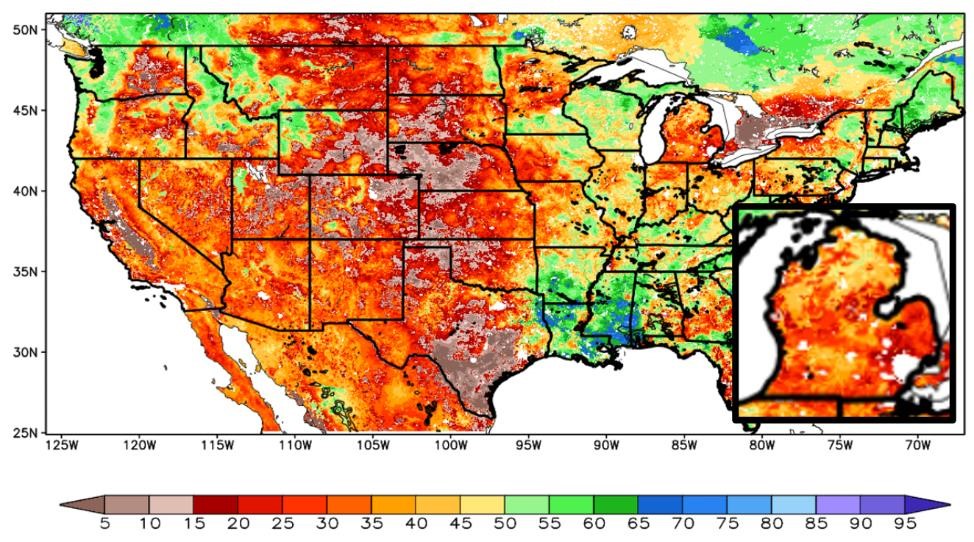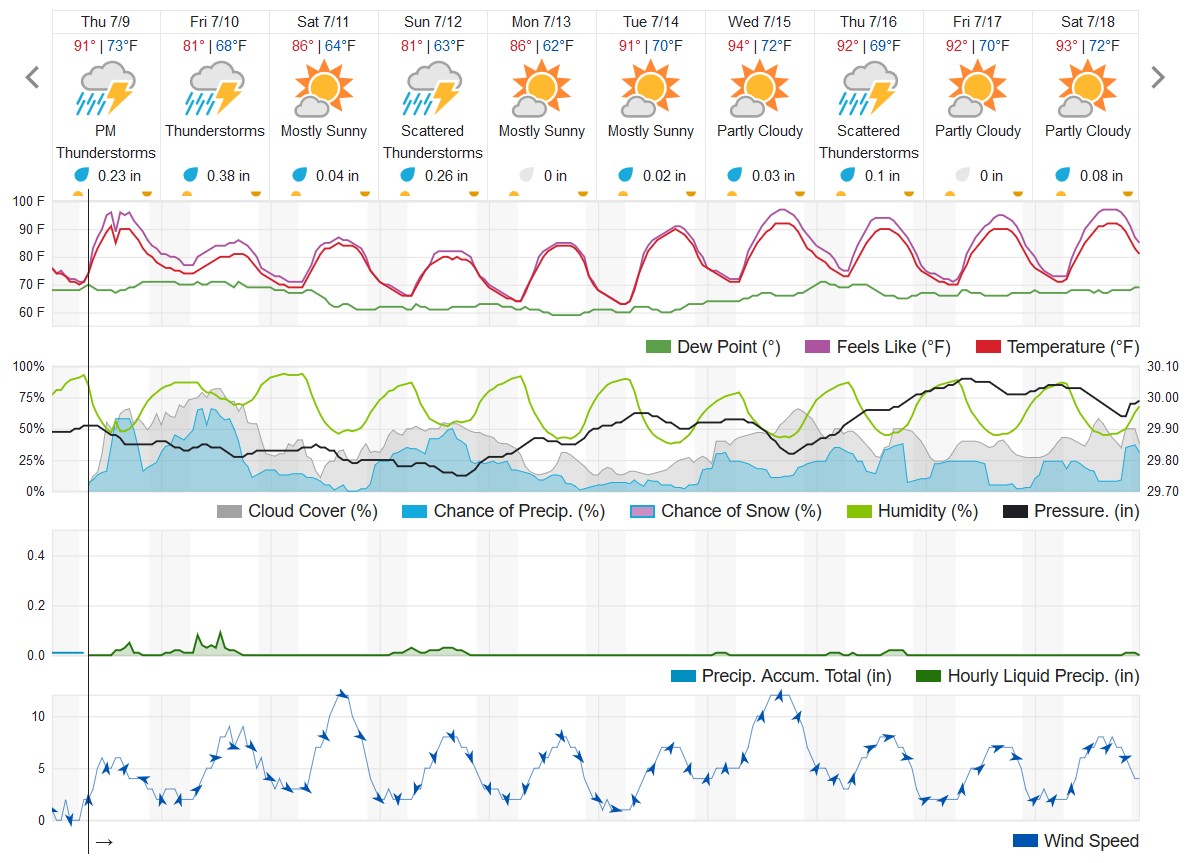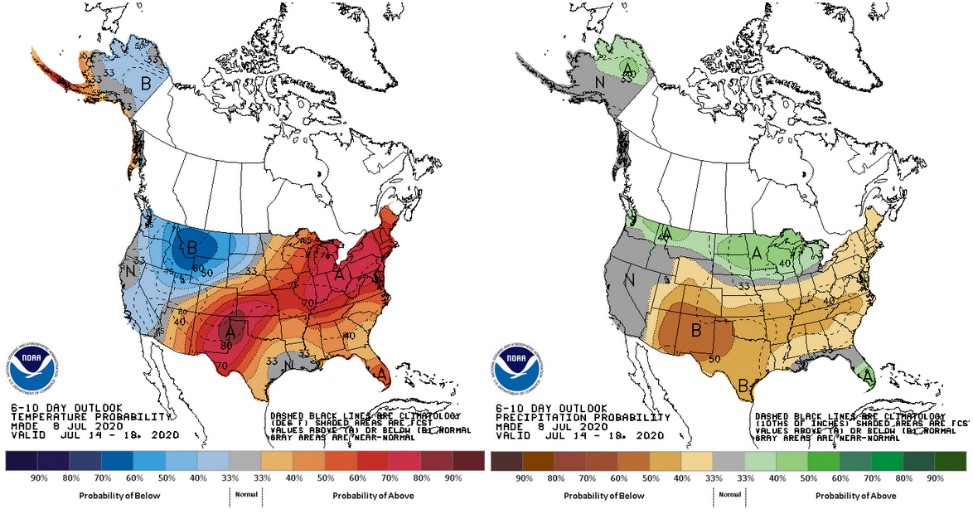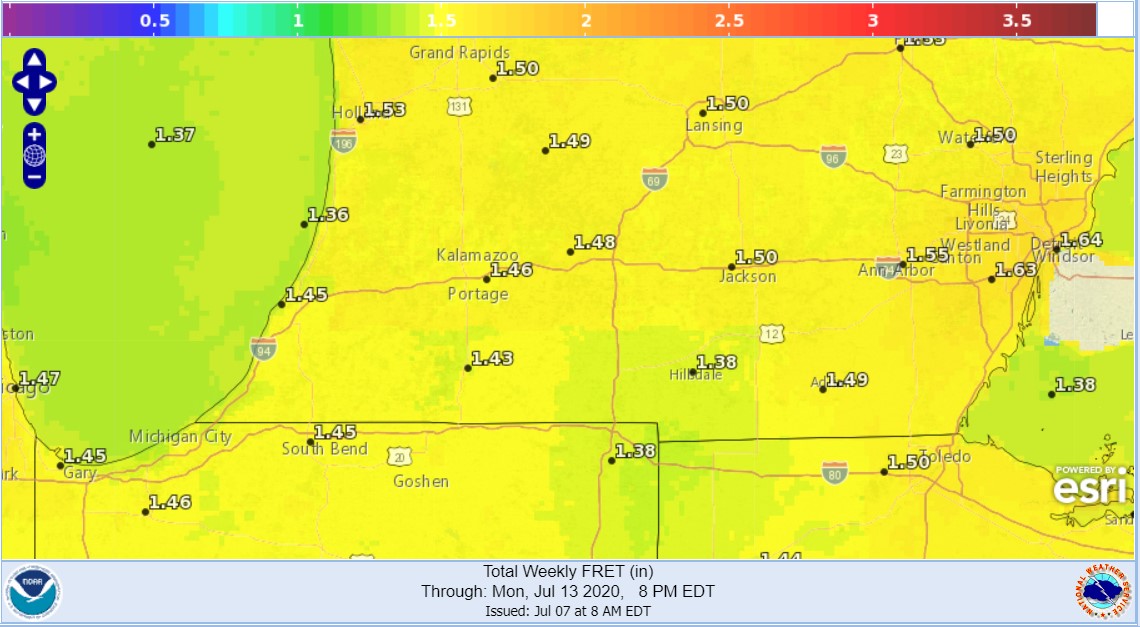Southwest Michigan field crop update – July 9, 2020
Drought conditions across much of the Corn Belt have hit Michigan’s Lower Peninsula. Rainfall is needed before we reach critical growth stages in our major crops.

Weather
Much of the Lower Peninsula has been nine to 10 consecutive days without precipitation, and soil moisture levels continue to decrease as the crops extract available water. Afternoon popup showers this past week brought localized rain with reports of as much as 2 inches or more in one field and no rain two miles away. The cold front that will be moving through Michigan on Friday and Saturday, July 10 and 11, will bring not only our next good chance of widespread rain but a 5-10 degree drop in daytime temperatures and slightly cooler nighttime temperatures over the weekend. Forecasted rainfall totals for southern Michigan for the next seven days are 0.75-1.50 inches. Temperature will turn hot again next week with daily highs in the 90s and little chance of rain through the third week of July.




Crops
Water stress symptoms in corn and soybean are easily seen in non-irrigated fields throughout the region. However, these do not yet appear to be widespread as crop roots have grown downward to search for deeper water. Typical leaf rolling in corn and leaf turning (showing the silvery underside) in soybean can be seen along headlands where compaction is restricting root growth and on sandier knolls.
Wheat harvest has begun, but dry conditions can still impact grain fill in later developing fields.
Diseases and insects
The hot and dry weather has kept disease progression from advancing in most cases. White mold in soybean is favored under moist conditions, which has not been an issue, and only a few early reports of tar spot symptoms have come in. Problems with certain insects are more likely with these weather conditions, and MSU Extension field crops entomologist Christina DiFonzo published the following in her Fast Fonz Facts earlier this week.
Potato leafhopper arrived from the south in May and has been reproducing on crops and weeds. Potato leafhopper feeding causes leaf yellowing, or hopper burn, on sensitive crops: alfalfa, dry beans, and commercial and garden vegetables. Both adults and nymphs cause this injury and symptoms can occur quickly as populations build. I have already seen pictures of hopper burn in dry beans and heard of fields over threshold. Potato leafhopper is easy to manage and the thresholds are good. Dry bean threshold: one potato leafhopper per trifoliate. Alfalfa threshold, number of potato leafhopper per 100 sweeps (by plant height): 50 (3-8 inches), 100 (8-12 inches) or 200 (over 12 inches)

Tarnished plant bug is normally found in all field crops in the state. It sucks plant juices from leaves and may pierce beans later in the season. It usually doesn’t cause significant problems except to sugarbeets, where fed-on leaves turn a characteristic bright yellow or brown at tips and edges. Some refer to this as stinging, but the injury comes from the bugs feeding on the plant. Stinging is most common in beets adjacent to recently harvested alfalfa, as bugs leave the forage field in large numbers. Plant bug injury is frustrating from a management standpoint since the damage happened a week or two before and spraying doesn’t help.
Thrips are normally present in fields the summer in Michigan, but they rarely increase to damaging levels in field crops. However, those in the Thumb may remember a thrips infestation on dry beans, soybeans and beets during a dry spell in 2018. Thrips punch into plant cells and suck the juices. Punctured cells dry out, creating silvery patches where many cells have collapsed. Under the worst damage, whole leaves dry up and die. A not-very-good-guess for spraying: the upper part of the plant (newer growth) is being affected by feeding and thrips are easy to find. To complicate things, thrips are semi-beneficial because they are predators of spider mite eggs. Spraying for them may be counterproductive if spider mite control is reduced.
For my money, the most worrisome pest is spider mite because it is so gosh-darn hard to manage, especially if it increases early in the season. All field crops are at risk, including hemp. Fruit and vegetable folks in the state are already talking about mites in their crops. Infestations can start innocently enough, on field edges near ditch banks or dirt roads. But mites reproduce parthenogenetically (without mating), so populations can explode in hot, dry weather. Spraying for another insect can exacerbate the situation by killing mite predators and releasing the mites from biocontrol. Spraying for mites themselves can be a losing game if coverage is poor or the wrong product is used. Finally, selective miticides can be expensive on low-margin field crops. Spider mites are just a pain in the butt. For information, go to the Michigan State University Field Crops Entomology Extension page and scroll down to the heading “Spider Mite” for corn and soybean decision sheets and a miticide cheat sheet for several crops.
Irrigation
Irrigated corn has its highest water use and realizes its greatest potential benefit from irrigation during the week of tasseling and the following three weeks. Most irrigation scheduling programs have corn using 120% of a 6-inch grass reference evapotranspiration (ET0), which translates to a water need for as much as 2 inches per week in corn fields near tassel.
Supplying adequate water during the week before and three weeks after tasseling is critical to obtain top corn yields. This period often occurs during the dry point in the summer when rainfall rarely meets crop water needs. In early and late summer, producers can save irrigation water and energy by using rainfall and “stored” soil moisture as much as possible. Irrigators striving for water and energy savings will let the crop deplete the available soil moisture to almost 50%, the point at which corn will start to roll in on a hot afternoon. During the critical week before and three weeks after tassel emergence, maintaining higher soil moisture reduces yield risk and maximizes water use efficiency.




 Print
Print Email
Email